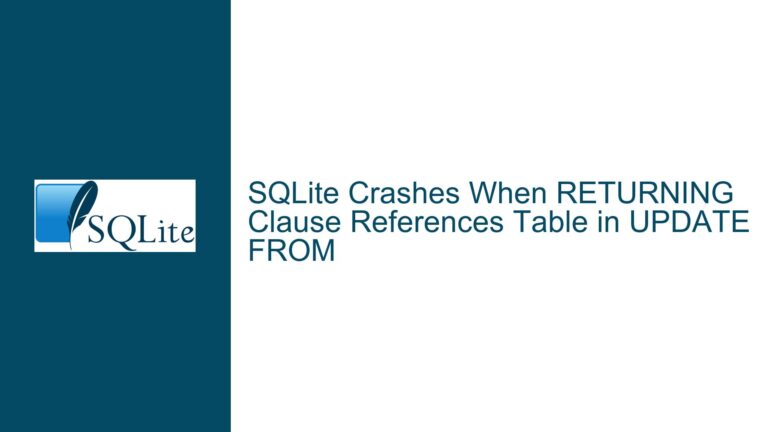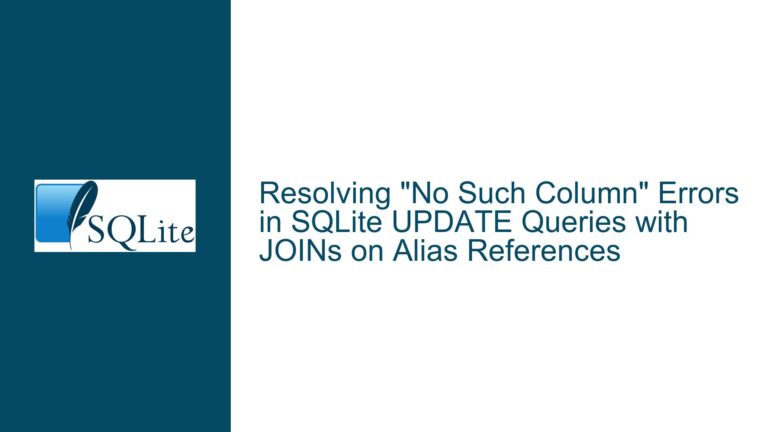Floating-Point Precision and CAST Issues in SQLite
Floating-Point Arithmetic and Its Impact on CAST Operations
Issue Overview
The core issue revolves around the unexpected behavior observed when casting the result of a summation operation to an integer in SQLite. Specifically, the query SELECT SUM(Utilization) AS ttl_sum, CAST(SUM(Utilization) AS INTEGER) AS cast_sum FROM OperationProcess; yields a sum of 3.0 for ttl_sum but a cast result of 2 for cast_sum. This discrepancy is not due to a bug in SQLite but rather a fundamental aspect of how floating-point arithmetic works in computer systems.
Floating-point numbers are represented in a binary format that cannot precisely represent all decimal fractions. This limitation leads to small rounding errors that can accumulate during arithmetic operations. In the provided example, the values in the Utilization column are decimal fractions that do not have exact binary representations. When these values are summed, the result is very close to 3.0 but not exactly 3.0. The internal representation of the sum might be something like 2.9999999999999995559, which, when cast to an integer, truncates to 2.
Understanding this behavior requires a deep dive into the nature of floating-point arithmetic, the limitations of binary representation, and how SQLite handles these types internally. The issue is not unique to SQLite; it is a common challenge in any system that uses floating-point arithmetic.
Possible Causes
The primary cause of the observed behavior is the inherent imprecision of floating-point arithmetic. Floating-point numbers are stored in a binary format that approximates decimal fractions. This approximation can lead to small errors that become significant when performing operations like summation. In the context of SQLite, the NUMERIC type used for the Utilization column is treated as a floating-point number, which means that the values stored in this column are subject to these rounding errors.
Another contributing factor is the way SQLite handles type conversion. When you cast a floating-point number to an integer, SQLite performs a truncation operation, which simply removes the fractional part of the number. This truncation does not involve any rounding, so a value like 2.9999999999999995559 becomes 2 when cast to an integer.
The specific values in the OperationProcess table exacerbate this issue. The values 0.05, 0.049, 0.9, and 0.001 are all decimal fractions that do not have exact binary representations. When these values are summed, the small errors in their binary approximations accumulate, resulting in a sum that is very close to 3.0 but not exactly 3.0.
Troubleshooting Steps, Solutions & Fixes
To address this issue, it is essential to understand the limitations of floating-point arithmetic and how to work around them. Here are several approaches to mitigate the problem:
Use the
ROUNDFunction: One straightforward solution is to use theROUNDfunction before casting the result to an integer. TheROUNDfunction allows you to specify the number of decimal places to round to, which can help mitigate the effects of floating-point imprecision. For example, the querySELECT SUM(Utilization) AS ttl_sum, CAST(ROUND(SUM(Utilization)) AS INTEGER) AS cast_sum FROM OperationProcess;will round the sum to the nearest integer before casting, resulting in the expected value of3.Store Values as Integers: Another approach is to store the values as integers and adjust for the decimal places during retrieval. This method avoids the issues associated with floating-point arithmetic altogether. For example, instead of storing
0.05, you could store50and then divide by1000when retrieving the value. The querySELECT FORMAT('%.3f', TOTAL(c) / 1000) FROM t;demonstrates this approach, where the values are stored as integers and divided by1000to get the correct decimal representation.Understand Floating-Point Representation: Educating yourself about the limitations of floating-point arithmetic is crucial. The document "What Every Computer Scientist Should Know About Floating-Point Arithmetic" is an excellent resource for understanding the nuances of floating-point representation and arithmetic. By understanding these concepts, you can make informed decisions about how to handle numerical data in your database.
Use Decimal Arithmetic Libraries: If precise decimal arithmetic is critical for your application, consider using a library or extension that supports decimal arithmetic. Some databases offer extensions or libraries that provide precise decimal arithmetic, which can be used to avoid the pitfalls of floating-point arithmetic.
Avoid Unnecessary Casting: In some cases, it may be possible to avoid casting altogether. If the fractional part of the number is not needed, consider using integer arithmetic from the start. This approach can simplify your queries and avoid the issues associated with floating-point arithmetic.
Test and Validate: Always test your queries with a variety of data to ensure that they behave as expected. In the case of floating-point arithmetic, it is especially important to test with edge cases and values that are known to cause issues. By validating your queries, you can identify and address potential problems before they affect your application.
Consider Alternative Data Types: If floating-point arithmetic is not suitable for your application, consider using alternative data types that provide the precision you need. For example, some databases offer fixed-point decimal types that can store decimal values with a fixed number of decimal places. These types can provide the precision needed for financial calculations and other applications where floating-point arithmetic is not appropriate.
Use Explicit Rounding in Calculations: When performing calculations that involve floating-point numbers, consider using explicit rounding at each step to minimize the accumulation of errors. For example, if you are summing a series of floating-point numbers, round each intermediate result to the desired precision before adding it to the total. This approach can help reduce the impact of floating-point imprecision on the final result.
Monitor and Adjust Precision: In some cases, it may be necessary to adjust the precision of your calculations to achieve the desired results. For example, if you are working with very small or very large numbers, you may need to increase the precision of your calculations to avoid losing significant digits. By monitoring the precision of your calculations and adjusting as needed, you can ensure that your results are accurate and reliable.
Leverage SQLite’s Type Affinity: SQLite uses a dynamic type system, which means that the type of a value is associated with the value itself, not the column in which it is stored. This feature allows you to store values of different types in the same column, but it also means that you need to be careful about how you handle type conversions. By understanding SQLite’s type affinity rules, you can write queries that take advantage of the flexibility of the dynamic type system while avoiding common pitfalls.
In conclusion, the issue of incorrect results when casting floating-point numbers to integers in SQLite is a common challenge that arises from the limitations of floating-point arithmetic. By understanding the underlying causes and implementing appropriate solutions, you can ensure that your queries produce accurate and reliable results. Whether you choose to use the ROUND function, store values as integers, or leverage alternative data types, the key is to be aware of the limitations of floating-point arithmetic and take steps to mitigate their impact on your calculations.






